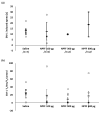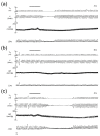Intracerebroventricular Neuropeptide FF Diminishes the Number of Apneas and Cardiovascular Effects Produced by Opioid Receptors' Activation
- PMID: 33255594
- PMCID: PMC7728097
- DOI: 10.3390/ijms21238931
Intracerebroventricular Neuropeptide FF Diminishes the Number of Apneas and Cardiovascular Effects Produced by Opioid Receptors' Activation
Abstract
The opioid-induced analgesia is associated with a number of side effects such as addiction, tolerance and respiratory depression. The involvement of neuropeptide FF (NPFF) in modulation of pain perception, opioid-induced tolerance and dependence was well documented in contrast to respiratory depression. Therefore, the aim of the present study was to examine the potency of NPFF to block post-opioid respiratory depression, one of the main adverse effects of opioid therapy. Urethane-chloralose anaesthetized Wistar rats were injected either intravenously (iv) or intracerebroventricularly (icv) with various doses of NPFF prior to iv endomorphin-1 (EM-1) administration. Iv NPFF diminished the number of EM-1-induced apneas without affecting their length and without influence on the EM-1 induced blood pressure decline. Icv pretreatment with NPFF abolished the occurrence of post-EM-1 apneas and reduced also the maximal drop in blood pressure and heart rate. These effects were completely blocked by the NPFF receptor antagonist RF9, which was given as a mixture with NPFF before systemic EM-1 administration. In conclusion, our results showed that centrally administered neuropeptide FF is effective in preventing apnea evoked by stimulation of μ-opioid receptors and the effect was due to activation of central NPFF receptors. Our finding indicates a potential target for reversal of opioid-induced respiratory depression.
Keywords: NPFF receptors; apnea; endomorphin-1; neuropeptide FF; μ-opioid receptors.
Conflict of interest statement
The authors declare no conflict of interest.
Figures




Similar articles
-
Neuropeptide FF attenuates the acquisition and the expression of conditioned place aversion to endomorphin-2 in mice.Behav Brain Res. 2013 Jul 1;248:51-6. doi: 10.1016/j.bbr.2013.03.046. Epub 2013 Apr 8. Behav Brain Res. 2013. PMID: 23578757
-
Pharmacological characterization of EN-9, a novel chimeric peptide of endomorphin-2 and neuropeptide FF that produces potent antinociceptive activity and limited tolerance.Neuropharmacology. 2016 Sep;108:364-72. doi: 10.1016/j.neuropharm.2016.03.017. Epub 2016 Mar 9. Neuropharmacology. 2016. PMID: 26970017
-
Effects of neuropeptide FF and related peptides on the antinociceptive activities of VD-hemopressin(α) in naive and cannabinoid-tolerant mice.Eur J Pharmacol. 2015 Nov 15;767:119-25. doi: 10.1016/j.ejphar.2015.10.016. Epub 2015 Oct 16. Eur J Pharmacol. 2015. PMID: 26472125
-
Modulatory role of neuropeptide FF system in nociception and opiate analgesia.Neuropeptides. 2008 Feb;42(1):1-18. doi: 10.1016/j.npep.2007.06.004. Epub 2007 Sep 12. Neuropeptides. 2008. PMID: 17854890 Review.
-
Neuropeptide FF modulates neuroendocrine and energy homeostasis through hypothalamic signaling.Chin J Physiol. 2019 Mar-Apr;62(2):47-52. doi: 10.4103/CJP.CJP_23_19. Chin J Physiol. 2019. PMID: 31243174 Review.
Cited by
-
Renal autocrine neuropeptide FF (NPFF) signaling regulates blood pressure.Sci Rep. 2024 Jul 4;14(1):15407. doi: 10.1038/s41598-024-64484-9. Sci Rep. 2024. PMID: 38965251 Free PMC article.
-
An Overview on Renal and Central Regulation of Blood Pressure by Neuropeptide FF and Its Receptors.Int J Mol Sci. 2024 Dec 11;25(24):13284. doi: 10.3390/ijms252413284. Int J Mol Sci. 2024. PMID: 39769048 Free PMC article. Review.
-
Sufentanil alleviates cerebral ischemia-reperfusion injury by inhibiting inflammation and protecting the blood-brain barrier in rats.Eur J Histochem. 2022 Jan 12;66(1):3328. doi: 10.4081/ejh.2022.3328. Eur J Histochem. 2022. PMID: 35016494 Free PMC article.
-
Alterations of pleiotropic neuropeptide-receptor gene couples in Cetacea.BMC Biol. 2024 Sep 2;22(1):186. doi: 10.1186/s12915-024-01984-0. BMC Biol. 2024. PMID: 39218857 Free PMC article.
-
Peptides for Health Benefits 2020.Int J Mol Sci. 2022 Jun 16;23(12):6699. doi: 10.3390/ijms23126699. Int J Mol Sci. 2022. PMID: 35743143 Free PMC article.
References
-
- Han J.-S. Chapter 210–Antiopioid peptides. In: Kastin A.J., editor. Handbook of Biologically Active Peptides. 2nd ed. Academic Press; Boston, MA, USA: 2013. pp. 1543–1549.
MeSH terms
Substances
Grants and funding
LinkOut - more resources
Full Text Sources
Molecular Biology Databases
Research Materials

